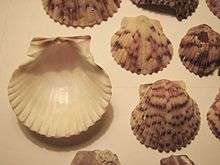Argopecten gibbus
| Atlantic calico scallop | |
|---|---|
 | |
| Single valves of the Atlantic callico scallop Argopecten gibbus | |
| Scientific classification | |
| Kingdom: | Animalia |
| Phylum: | Mollusca |
| Class: | Bivalvia |
| Order: | Ostreoida |
| Family: | Pectinidae |
| Genus: | Argopecten |
| Species: | A. gibbus |
| Binomial name | |
| Argopecten gibbus (Linnaeus, 1767) | |
The Atlantic calico scallop, Argopecten gibbus, is a species of medium-sized edible marine bivalve mollusk in the family Pectinidae, the scallops.
This species was once the basis of an important fishery, but in recent years catches have been low.[1]
Description
This species grows up to three inches in maximum width, and is similar in shape and sculpturing to the Atlantic bay scallop. Both valves of the shell are cupped. The shell near the hinge is extended into "ears", as is the case in all scallops. The shell of the Atlantic calico scallop has about 20 radial ribs, which are sometimes roughened by growth lines.
The exterior coloration of the upper (left) valve is dark yellow or pink, with striking blotches of red which sometimes form stripes. The lower (right) valve of this scallop is whitish with small reddish or purple spots. It has a white interior, often with brown patches on the "ears" and top edge.
The lively outer coloration of the shell of this species gave rise to its popular name; in the USA, "calico" was for many years an inexpensive but colorful fabric printed with small flower patterns.
Habitat
The Atlantic calico scallop lives in the ocean (it is not found in bays) east of Cape Lookout and southwest of Beaufort Inlet and lives in up to 100-foot depths. The shells are commonly found washed up on sound and ocean beaches.
This species ranges from Delaware to Brazil and is still sometimes fished commercially.
Valve color and shell morphometry distinguish calico scallops from related species. The Atlantic calico is distinguished by the yellowish to white coloration and splotchy patches of bright red, maroon, or lavender. It is slightly convex in the left (upper) valve (Broom 1976).
in the Indian River Lagoon in Florida, two other scallops occur: the bay scallop, (Argopecten irradians), which generally has a uniform gray to gray-brown coloration with distinct convexity of the right (lower) valve. The other is the rough scallop, (Aequipecten muscosus), which has unequal 'ears' and has sharp scales on the lower surface of the ribs. The color of the rough scallop is yellow, orange, red or brownish.